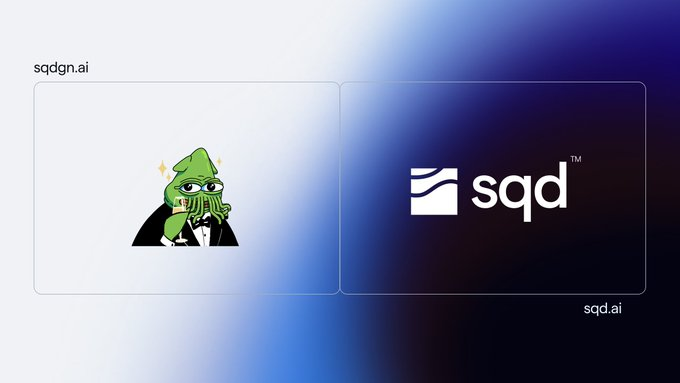Subsquid: The Next-Gen On-Chain Data Infrastructure
Subsquid (SQD) is a decentralized blockchain data indexing protocol that redefines on-chain data access through a modular data lake architecture. The project aims to solve the speed bottlenecks of traditional indexing solutions (e.g., The Graph requires over 6 seconds for confirmation) and the fragmentation across chains, supporting real-time queries across over 100 chains including Ethereum and Solana. In June 2025, its token SQD launched on Binance Alpha and was added to the Coinbase listing roadmap, making it the first indexing protocol endorsed by both major exchanges—validating the market value of decentralized data infrastructure.

This Token Insights article delves into Subsquid’s technical framework and tokenomics, exploring how it resolves delays and cost issues in on-chain indexing.
Technical Architecture: Three-Layer Model Breaks Through Performance Bottlenecks
The data lake layer is Subsquid’s core innovation. It stores raw on-chain data via distributed nodes, using zero-knowledge proofs (ZKPs) to verify integrity—ensuring data is tamper-proof without needing trusted intermediaries. Unlike traditional solutions, its real-time indexing layer supports processing of unconfirmed blocks, reducing latency to 800 milliseconds—ideal for high-frequency strategies like arbitrage bots to capture fleeting opportunities.
The query engine layer uses the Squid SDK (TypeScript) to significantly lower the developer barrier. Users can customize ETL processes and aggregate data across 10+ chains in a single request. For example, when DeFi protocol Aave uses Subsquid to monitor liquidation risks across chains, development time is reduced by 70% and costs are 73% lower than The Graph (average query cost is $0.0008).
Tokenomics: High-Yield Staking Drives Ecosystem Loop
The SQD token forms a four-dimensional value cycle:
-
Payment Fuel: Projects use SQD to pay for data query services, with 70% of fees distributed to node operators;
-
Staking Incentives: Both nodes and data consumers can stake tokens to earn up to 55% APY, with over 35% of tokens currently locked;
-
Governance Voting: Holders vote on protocol upgrades (e.g., adding support for new chains);
-
Deflation Mechanism: A portion of query fees are burned to combat inflation.
This model has attracted over 300 project deployments (including Galxe and Aave), with node count growing 400% in three months. However, high APYs depend on protocol revenue—if query demand lags behind token release, yield dilution may occur.
Exchange Endorsement & Market Reaction
Two key events in June 2025 solidified its market position:
-
Binance Alpha Launch (June 2): Airdrop of 424 SQD (costing 15 points); over 80,000 addresses claimed within 24 hours. A trading competition attracted 13,000 users sharing 4.42 million tokens;
-
Coinbase Listing Roadmap (June 6): SQD plans to debut on Arbitrum. The announcement caused a 12% price spike.
These endorsements boosted ecosystem metrics: developer adoption rose 220% quarter-on-quarter, daily query volume exceeded 5 million. Liquidity expectations pushed institutional holdings from 3% to 15%, following a trajectory similar to The Graph (GRT) after Coinbase listing.
Competitive Landscape: Real-Time Speed and Multi-Chain Synergy
Compared to traditional indexers like The Graph, Subsquid stands out through three differentiators:
-
Real-Time Superiority: The Graph waits for block confirmation (6+ sec), while Subsquid indexes unconfirmed blocks with 800ms latency—ideal for high-frequency strategies;
-
Multi-Chain Synergy: Subsquid eliminates redundant deployments. A single request aggregates data across Ethereum, Solana, and others, while The Graph requires per-chain subgraphs;
-
Flexible Payments: Supports both fiat and crypto, avoiding The Graph’s GRT-only payment bottleneck.
These advantages fuel Subsquid’s adoption in DeFi and AI Agent sectors. Projects like HeyElsaAI have integrated it as their real-time data backend.
Risks & Challenges: Balancing Optimization and Compliance
Technical Bottlenecks
-
ZKP Overhead: Proof generation consumes computational resources, increasing node costs by 35% annually; requires optimization of proof compression algorithms.
-
Cross-Chain Security: Solana-EVM bridges face asynchronous attack risks—third-party audits are needed.
Global Regulatory Tensions
-
US SEC: Data services may be deemed “unregistered securities brokers,” referencing the Coinbase lawsuit.
-
EU MiCA: Requires a Class A license for data services; cross-border transfers must comply with GDPR localization.
Regulatory updates can be tracked via the JuCoin Compliance Center.
Future Evolution: From Data Pipeline to AI Infrastructure
Subsquid’s roadmap focuses on three strategic directions:
-
AI Agent Integration (Q3 2025): Provides real-time on-chain data streams for LLM training—partnership with HeyElsaAI already in place;
-
RegTech Expansion: Developing on-chain asset tracking templates for tax authorities, entering the enterprise sector;
-
Full Public Chain Coverage: By 2026, plans to integrate Aptos and Sui, reaching 90% multi-chain coverage.
If 55% APY remains sustainable, staking ratio may surpass 60%, significantly easing sell pressure. As RWA and AI sectors explode, decentralized data indexing may become the core infrastructure layer of Web3, redefining the information flow paradigm of the value internet.




